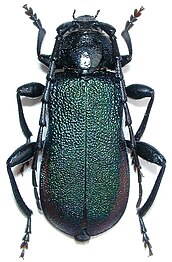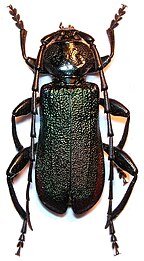Ropalopus insubricus
| Ropalopus insubricus | |
|---|---|

| |
| Male Specimen of Ropalopus Insubricus | |
| Scientific classification | |
| Domain: | Eukaryota |
| Kingdom: | Animalia |
| Phylum: | Arthropoda |
| Class: | Insecta |
| Order: | Coleoptera |
| Suborder: | Polyphaga |
| Infraorder: | Cucujiformia |
| Family: | Cerambycidae |
| Genus: | Ropalopus |
| Species: | R. insubricus
|
| Binomial name | |
| Ropalopus insubricus Ernst Friedrich Germar, 1824
| |
| Synonyms[1] | |
| |
Ropalopus insubricus is a rare species of European long-horned beetle in the family Cerambycidae.[1] It was first documented by Ernst Friedrich Germar in 1824 and first assessed for the IUCN Red List in 2009.[1][2] The species is quite rare in Europe and is classified as Near Threatened.[2]
Description
[edit]Ropalopus insubricus is a species within the genus Ropalopus. It is characterized by its distinct morphological features.[1] The species measures between 14 mm (0.55 in) and 31 mm (1.22 in) in length, it is identified by densely reticulated elytra lacking wrinkles in the basal half.[3][4] The pronotum is unevenly tapered, featuring a large rhomboid area with slight punctation.[4] In males, the lustrous pronotum contrasts with other subspecies, and the antennae are notably longer than the elytra.[4] Pronotum stains are characterized by deeper punctation, narrow irregularities, and a non-merging pattern.[4] Ropalopus insubricus is diurnal, with the species being particularly active during the warm daylight hours. [5]
-
Female
-
Male
Life cycle
[edit]The life cycle of the Ropalopus insubricus beetle species spans 2 to 3 years. Adult beetles emerge ready to fly between May and August.[6][7] The larvae of Ropalopus insubricus undergo development in damaged sections of living trees, pupating in the heartwoods under the bark.[2][4][7] Observed variations in the pronotum and elytra shape, as well as the distinct body coloration, within the same population are likely a result of larval development and pupation occurring under the bark and inside the wood of living trees, exposing the immature stages to different pressures.[4]
Distribution and habitat
[edit]Ropalopus insubricus, classified as an obligate saproxylic species, demonstrates a strong dependence on decaying wood throughout its life stages.[2] Preferring mountainous environments, this species is prevalent from northern Italy through Slovakia to Hungary and the Balkans, extending into westernmost Turkey.[2][4][8] The species is extremely rare only having two recorded occurrences in Turkey over the past 114 years.[9] Host trees, particularly broad-leaved species such as Acer, Ficus, Fraxinus, Alnus, and Fagus, play a crucial role in supporting the life cycle of this species.[2]
Ropalopus insubricus exhibits a degree of adaptability beyond montane habitats, as evidenced by its presence on road verges or Ficus plantations.[2] Suspected to require a warm climate at low altitude for optimal development, Ropalopus insubricus is distributed across more temperate regions of Europe.[2] Ropalopus insubricus can only be found at elevations lower than 600 meters (1968.5 feet) above sea level.[4]
Conservation status
[edit]Ropalopus insubricus is classified as Near Threatened on the IUCN Red List due to the rarity of the species.[2] Deforestation and forest fragmentation are contributing factors to its classification.[2]
See also
[edit]References
[edit]- ^ a b c d Zicha, Ondrej. "BioLib: Biological library". www.biolib.cz. Retrieved 2023-12-25.
- ^ a b c d e f g h i j "Ropalopus insubricus". iucnredlist.org. Retrieved December 24, 2023.
- ^ "Ropalopus ungaricus insubricus". www.cerambyx.uochb.cz. Retrieved 2023-12-25.
- ^ a b c d e f g h Karpinski, Lech; Szczepanski, Wojciech T.; Kruszelnicki, Lech (October 30, 2019). "Revision of the Ropalopus ungaricus/insubricus group (Coleoptera: Cerambycidae: Callidiini) from the western Palaearctic region" (PDF). Zoological Journal of the Linnean Society. 189 (4): 1176–1216. doi:10.1093/zoolinnean/zlz154 – via cerambyx.uochb.cz.
- ^ Simon, A. (1954). "Note sur l'Éthologie de Rhopalopus Insubricus Germ. (Col. Cerambycidae)". Annales de la Société entomologique de France. 123 (1): 35–42. doi:10.1080/21686351.1954.12279073 – via Taylor & Francis Online.
- ^ "Ropalopus insubricus". cerambyx.uochb.cz. Retrieved 2024-01-05.
- ^ a b "Ropalopus insubricus (Germar, 1824) - Xylophagous Insects". www.forestpests.org. Retrieved 2024-01-05.
- ^ Paleart, Cerambycidae of the. "Longhorn beetle - Cerambycinae - Callidiini - Ropalopus insubricus insubricus Germar, 1824". Cerambycidae of the Paleart (in Czech). Retrieved 2023-12-25.
- ^ Cebeci, Hüseyin; Özdikmen, Hüseyin; Turgut, Semra (February 6, 2011). "Callidiine species in Turkey with zoogeographical remarks and some interesting and rare records (Coleoptera: Cerambycidae: Cerambycinae)". Journal of Natural History. 45 (7–8): 475–483. Bibcode:2011JNatH..45..475C. doi:10.1080/00222933.2010.534193. S2CID 84403179 – via Taylor & Francis Online.
External links
[edit]



